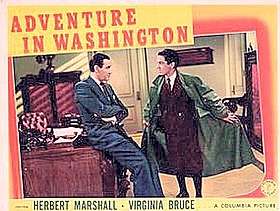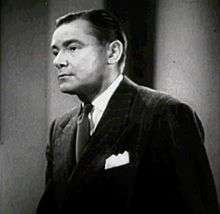Adventure in Washington
Adventure in Washington is a 1941 American drama film directed by Alfred E. Green and starring Herbert Marshall, Virginia Bruce and Gene Reynolds.[1] The plot is about an unlikely U.S. Senate page boy whose misadventures in Washington, D.C., cause a Congressional scandal.
| Adventure in Washington | |
|---|---|
 | |
| Directed by | Alfred E. Green |
| Produced by | Charles R. Rogers |
| Written by | Jeanne Spencer Albert Benham |
| Screenplay by | Arthur Caesar Lewis R. Foster |
| Starring | Herbert Marshall Virginia Bruce Gene Reynolds |
| Music by | W. Franke Harling |
| Cinematography | Henry Sharp Allen G. Siegler |
| Edited by | James Sweeney |
Production company | |
| Distributed by | Columbia Pictures |
Release date | May 30, 1941 |
Running time | 84 minutes |
| Country | United States |
| Language | English |
Based on a story by Jeanne Spencer and Albert Benham,[2] the film was originally conceived in 1940 as a sequel to Columbia Pictures' hit film of the previous year set in the United States Senate, Mr. Smith Goes to Washington, with Mickey Rooney in mind for the part of a juvenile delinquent who becomes a Senate page.[3]
Gene Reynolds eventually got the role of the page when filming began in 1941. Virginia Bruce plays a female radio reporter covering the Capitol Hill beat, who fights for acceptance as a legitimate journalist in a male-dominated arena. Herbert Marshall's character as a prominent Senator eventually comes to appreciate her insights into human nature as well as her skill and they become close friends.
The film's sets designed by art director Lionel Banks were acclaimed for their attention to detail.[4] It was released in Britain under the alternative title of Female Correspondent.
Plot
Jim O'Brien (J. M. Kerrigan), an old friend of highly regarded U.S. Senator John Coleridge (Herbert Marshall), prevails upon the Senator to take under his wing a streetwise orphaned delinquent, teenager Marty Driscoll (Gene Reynolds), and appoint the youth as a Senate page boy. Because the boy's father had once helped Coleridge get his start in politics, the Senator reluctantly agrees.[2]
Marty continues to be a troublemaker as a Senate page, acting as a smart-aleck around the other pages and in their school classes. He resents having to wear the knickers required as part of the Senate pages' uniform at the time,[5] contending "I gave up short pants years ago". Told that it's a Senate tradition, he says, "I always thought knickers was for kids" (a scene depicted in the movie poster). He even gets into a fistfight with another page on the Senate floor (when the Senate is not in session) over a harmless initiation prank the other boys had played on him.[2]
Young Driscoll begins to mend his ways when he is befriended by female radio commentator Jane Scott (Virginia Bruce), whom he first met in the Senator's office. After being scolded by senior page Collins (Charles Smith) and upbraided by Sen. Coleridge for his disgraceful behavior, Driscoll seeks Jane's advice on how he can win approval. The two go bowling together, at her suggestion. In between frames, she counsels him not to use his fists to get his way, but instead to take advantage of the privileged opportunity he has been given as a Senate page to develop the personal qualities that will gain him the respect of others and develop into a leader for the right reasons. Heeding her advice, Marty's attitude improves markedly and he develops newfound pride in being a page and in wearing his uniform, much to the delight of Sen. Coleridge.[2]
However, when Marty is later wrongly accused by page headmaster Bundy (Vaughan Glaser) of eavesdropping on a private meeting of Senators and leaking confidential information, Sen. Henry Owens (Samuel S. Hinds), the senior Senator from Coleridge's state, demands that Coleridge dismiss Marty and send him home. Marty, with tears in his eyes, pleads with Coleridge not to fire him, protesting his innocence and vowing he would never betray his oath of fidelity as a Senate page.[2]
Distraught at being disbelieved by Coleridge and unjustly terminated, Marty finds himself an outcast sitting on a park bench in Washington. He decides to get revenge on Coleridge by turning over privileged information about an upcoming major defense appropriation bill being considered by Coleridge's committee to businessman Frank Conroy (Pierre Watkin). The unscrupulous Conroy, hoping to profit in the stock market from gaining this inside information, gives Marty a bribe.[2]
Meanwhile, the other pages rally to Marty's defense and appeal to Coleridge and Owens to reconsider their decision. Convinced by their sincerity, Coleridge informs his young protégé that the page appointment is his once again.[2]
Realizing that his reinstatement is jeopardized by what he has done, Marty hastens to Conroy's apartment in New York, offering to return the bribe money and begging him not to divulge the contents of the appropriations bill. Too late, Conroy replies, he's already shared the inside information with his group of investors, who hope to make a killing in the stock market.[2]
When the bill's provisions are subsequently publicized without committee approval, the stock prices of certain defense-related companies soar. The resulting uproar embroils Sen. Coleridge in controversy and he is investigated by his Senate colleagues for sharing nonpublic information with investors, a violation of Federal law.[2]
When Marty learns that his misconduct has landed his mentor in serious trouble, he is conscience-stricken and hitchhikes back to Washington, where he bursts into the investigating committee's hearing room to explain that he alone is to blame for the scandal. Although his full confession exonerates Coleridge, there remains the issue of what to do about Conroy's illegal conduct and Marty's complicity. The committee votes to indict Conroy and, at the urging of Coleridge, agrees to allow Marty's fate to be decided by his fellow pages.[2]
Meeting in the Senate chambers, one of the pages calls for Marty's dismissal because he's shown himself unfit to be a page. But another page, Abbott (Dickie Jones, who also played a page in Mr. Smith Goes to Washington), comes to his defense, pointing out that, unlike themselves who came from privileged backgrounds with loving parents who set a good example, Marty's lack of these advantages and his voluntary confession should be taken into consideration.[2]
After the pages decide that Marty may continue as one of their own, the film's final scene concludes as he rises to express his gratitude for their forgiveness. The reformed page gives a tearful peroration saying he's learned from those he's met there how to be an upstanding citizen, and especially that American representative democracy is government "of the people, by the people, for the people", as he recites from memory The American's Creed.[2]
Main cast

- Herbert Marshall as Sen. John Coleridge
- Virginia Bruce as Jane Scott
- Gene Reynolds as Marty Driscoll
- Samuel S. Hinds as Sen. Henry Owen
- Ralph Morgan as Sen. Cummings
- Vaughan Glaser as Bundy
- Charles Smith as Collins
- Dickie Jones as Abbott
- Pierre Watkin as Frank Conroy
- J. M. Kerrigan as Jim O'Brien
- Tommy Bond as Peewee Haynes
- Bess Flowers as Mrs. Arno (uncredited)
- Ian Wolfe as Emerson (uncredited)
- Billy Dawson as Chubby Wells
- Charles Lind as Lenny Root
- Mary Currier as Miss Nolan
Production
The film was originally conceived in 1940 with Mickey Rooney in mind, as a sequel to Columbia Pictures' hit film of the previous year, Mr. Smith Goes to Washington. [3] The Senate gave permission for its pages to travel to Hollywood for filming in the summer of 1940, but those plans fell through as World War II engulfed Europe.[3] After Mickey Rooney turned down the role of Marty Driscoll, 17-year old Gene Reynolds was cast for the part by the time shooting began on February 12, 1941.[3][6]
Considerable attention was paid to authentic set design for the Senate chamber, including accurate reproduction of the Senators' desks and other furnishings, down to the snuff boxes at the Vice President's rostrum.[4]
Female lead Virginia Bruce prepared for her role as a radio commentator by practicing the delivery style of fast-talking radio personality Floyd Gibbons.[4] For the bowling sequence, she spent two days in a bowling alley rehearsing and shooting the scene, using a special, lightweight ball made of balsa wood.[4]
Filming wrapped on March 24, 1941. Adventure in Washington was released on Memorial Day, May 30, 1941.[6]
Critical response
Not all members of Congress were pleased with the film's depiction of life on Capitol Hill, especially its scenes of fistfights and eavesdropping by pages. Congressman Donald McLean (R-NJ), in a speech in the U.S. House of Representatives, denounced the film's portrayal of things that didn't happen in real life. Having once been a Senate page himself 40 years before, he said it "undermine[d] the confidence of the electorate".[3]
International distribution of the film was not allowed by the Office of Censorship because of concerns that the storyline's portrayal of the bribing of a Senate page would "hinder the war effort".[6]
The Ames (Iowa) Daily Tribune praised the cast's performances and the film's relevance about defense spending "at a time when the eyes of the nation are centered on defense",[7] as WWII raged in Europe and tensions were rising between the U.S. and Japan. The newspaper lauded the cast as "splendid ... [having] roles calling for the utmost in their not inconsiderable talents". Actors Herbert Marshall and Gene Reynolds ("a new boy star") "possess roles of exceptional merit and provide performances to match", and Virginia Bruce gave a "memorable characterization" of the assertive reporter, the review said.[7]
The Atlanta Constitution in a June 1, 1941, review called Adventure in Washington "thrilling" and complimented the production for the extent of detail in the sets representing the Senate chamber and page classrooms, down to the desks "and even the snuff boxes at the rostrum".[4]
IMDb gives the film an aggregate score of 5.8/10, as of July 24, 2018.[8]
Home media
Adventure in Washington was released on DVD by Sony Pictures Home Entertainment as part of Sony's Choice Collection in 2013.[2]
References
- Stephens, Michael L. (2008). Art Directors in Cinema: A Worldwide Biographical Dictionary. McFarland, p.23.
- Adventure in Washington (DVD). Sony Pictures Home Entertainment. 2013. 4339642294.
- Gonzalez, Darryl J. (2010). The Children Who Ran For Congress: A History of Congressional Pages. Santa Barbara, Calif.: Praeger. p. 96. ISBN 9-7803-1338-6664. Retrieved July 21, 2018.
- "Look Out! Senate Page Boys Are On The Loose". Atlanta Constitution. June 1, 1941. p. 15C. Retrieved July 23, 2018.
- Gonzalez (2010), p. 83.
- Adventure in Washington at the American Film Institute Catalog. Retrieved July 24, 2018.
- "Splendid Cast in Story of Congressional Scandal". Ames Daily Tribune. July 12, 1941. p. 8. Retrieved July 23, 2018.
- Adventure in Washington on IMDb. Retrieved July 24, 2018.